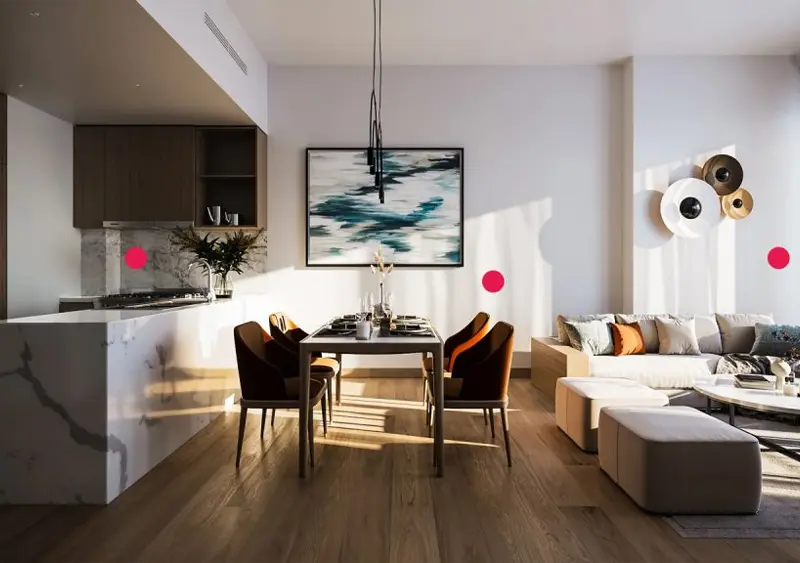Top Benefits of Using 3D Walkthrough Services in Architecture
Designs you can see, spaces you can feel.

5 MIN READ
August 6, 2025

Written By
Sasikumar Janakiraman
If you’ve ever had to explain a corridor flow or the placement of a skylight using technical terms alone, you already know how frustrating it is. Not because clients aren’t intelligent but because not everyone visualizes space the way architects do.
That’s where 3D walkthrough services come in. They bridge the gap between imagination and reality by putting people inside the space before a single brick is laid. No guesswork. No abstract talk. Just clear, immersive storytelling.
As more architecture firms, developers, and interior designers embrace this tool, it’s worth understanding exactly why these walkthroughs are becoming essential, not just trendy.
1. Brings Clarity to Complex Designs
Not all projects are straightforward. Sometimes, it’s a tricky site. Other times, the client has never worked with architects before. Even when everyone’s experienced, communicating spatial flow, volume, and ambience can be tough using just floor plans or still renders.
A 3D walkthrough turns complexity into clarity.
It gives the client a tour from the entrance to the back garden, from the stairwell to the top floor. They can see how the living space opens into the balcony, how light filters through the windows at different hours, and how materials interact across rooms.
This level of visualization leaves less room for misinterpretation. Clients can confidently approve a design because they don’t just understand it they’ve experienced it. For design teams looking to scale efficiently, understanding the benefits of outsourcing 3D architectural visualization can be a game-changer in delivering that clarity with speed and cost-effectiveness.
2. Reduces Rework and Late-Stage Changes
Here’s the hard truth: many changes that happen during construction could have been avoided if the client understood the design better at the start.
Let’s say a client approves a drawing showing a compact kitchen. But once it’s built, they walk in and realize it feels too tight. Now you’re looking at structural changes, time delays, and extra cost all of which impact your firm’s credibility and budget.
3D walkthroughs reduce this risk by catching design discomforts early.
Clients can flag layout concerns, awkward transitions, or proportions that don’t sit right all before construction begins. You get more accurate feedback, and they feel more involved in shaping the space.
It’s a win-win with fewer revisions, fewer site conflicts, and far less frustration for everyone involved.
3. Saves Time Across All Project Stages
Let’s be honest, time is always under pressure. Whether you’re pushing for approvals, coordinating with consultants, or juggling overlapping deadlines, anything that helps speed up communication is valuable.
3D walkthroughs do exactly that.
In client meetings, decisions are made faster because the visuals speak for themselves. Internally, your design team can catch inconsistencies or awkward transitions early. Even coordination with external vendors becomes easier when everyone is referencing the same immersive visual, rather than debating over technical line drawings.
Also, walkthroughs can be reused across project stages from early concept pitching to marketing handovers. That’s efficient content that keeps working for you.
4. Helps Clients Emotionally Connect with the Design
Architecture is technical, but it’s also deeply emotional. A home is someone’s dream. An office might represent growth. A school design reflects values of openness and safety. If your client can’t feel the design, they’re less likely to fall in love with it.
Walkthroughs create that emotional spark.
They let clients step into their future space. They imagine themselves walking through the door after a long day, holding meetings in the boardroom, or watching their kids play in the backyard.
This emotional connection builds trust. It turns your client into an advocate who supports your vision instead of constantly questioning it. That’s powerful and hard to replicate with any other tool.If you're working with an external team, here’s a helpful checklist for outsourcing 3D architectural rendering to make sure your vision stays emotionally compelling and technically sound.
5. Adds Immense Value in Marketing and Pre-Sales
Walkthroughs aren’t just for design reviews. They’ve quietly become a game-changer for marketing teams and developers too.
In real estate, for example, projects often go to market before construction even begins. A well-made 3D walkthrough becomes the hero asset for brochures, websites, and social media campaigns. It helps potential buyers visualize living there even when the site is still under excavation.
For commercial spaces, walkthroughs support investor pitches, leasing brochures, and even government approvals. A compelling walkthrough can tell a story that words and diagrams simply can’t.
And since they’re video-based, walkthroughs are easy to distribute, easy to consume, and incredibly shareable. One walkthrough can do the work of ten static presentations.Learn more about how to choose the right 3D walkthrough service provider.
6. Detects Flaws That 2D Plans Might Miss
Even the most experienced architect can overlook something on a flat drawing. Maybe it’s a light fixture that feels out of place once you see it overhead. Or a corridor that feels too dark. Or a wall finish that clashes with the flooring when seen in motion.
3D walkthroughs expose these subtle issues before they become expensive problems.
They let you test the space in motion. How does the hallway feel when you move through it? Does the ceiling height feel generous or cramped? Are the window placements maximizing light or blocking views?
Catching these details early helps refine the design not just for visual polish, but for practical comfort.
Conclusion
A few years ago, 3D walkthroughs were seen as a “nice-to-have.” Today, they’re quickly becoming a standard expectation from clients, collaborators, and even your own team. Why? Because they improve clarity, reduce confusion, and make the entire process more human.
In a world where attention spans are short and expectations are high, walkthroughs don’t just show what you’re building they show why it matters.
If you’re in architecture or real estate, now’s the time to bring immersive storytelling into your workflow. Because when your client can see it, they can believe in it.
Want to bring your designs to life before they’re built?
Zealous Services creates hyper-realistic 3D animation walkthroughs that let your clients
feel the space not just imagine it. Whether you're an architect, developer, or designer, we help you
communicate ideas clearly and impressively.
Get in touch with Zealous for immersive 3D walkthrough services tailored to your project vision.
About the writer :
Sasikumar Janakiraman, as the Creative Director at Zealous Services, brings a unique mix of creativity and technical ... skill. He’s passionate about 2D and 3D design, leading teams to create stunning 3D models and visualizations. Sasikumar loves working closely with clients, making sure their ideas come to life in the best possible way. His goal? To make design feel simple and exciting.
Read MoreFrequently Asked Questions (FAQ)
What exactly is a 3D walkthrough in architecture?
A 3D walkthrough is a digital animation that simulates movement through a proposed space. It lets clients experience the flow, layout, and atmosphere of a design before construction begins almost like a virtual tour of a space that hasn’t been built yet.
How is a 3D walkthrough different from a 3D render?
While a 3D render is a still image, a walkthrough is a moving visual. It lets you see how different areas connect, how lighting changes across the day, and how the space feels from different angles, offering a much deeper understanding of the design.
Do walkthroughs really help reduce client revisions?
Yes, they do. When clients can walk through a space and experience it visually, they’re more likely to catch layout concerns early. That leads to faster approvals and fewer costly changes during construction.
Are 3D walkthroughs useful for small architecture firms?
Absolutely. In fact, they can give smaller firms a competitive edge. Walkthroughs help build client trust, make presentations more engaging, and show professionalism that sets you apart regardless of firm size.
How long does it take to create a 3D walkthrough?
It depends on the complexity of the project. For a medium-scale residential or commercial space, it typically takes 7–14 days. At Zealous, we manually craft each walkthrough for precision, realism, and maximum visual impact.